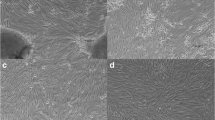Abstract
This report describes some unsuccessful attempts to produce continuous cell lines from penaeid prawn tissues in the late 1980s. This information is presented so that others might save time by not repeating the unsuccessful measures that were attempted. The osmolarity of Penaeus monodon haemolymph was measured at 687 mOsmol/kg (N = 10). Of the media tested, the best medium for cell growth and maintenance was shown to be double strength L-15, supplemented with 10% foetal bovine serum, and 10% prawn muscle extract at 28 °C (∼675.5 mOsmol/kg). Prawn muscle extract was made by homogenising 30 g of prawn muscle in 50/50 ratio of distilled water/autoclaved seawater, clarified stepwise by centrifugation at 2k, 14k, 14k ×g for 30 minutes each. The resultant supernatant was heat-inactivated on occasions with no improvement in growth. Preconditioned medium, cholesterol, galactose and trehalose supplements and the use of Cell-TakTM did not improve growth conditions, and haemolymph extracts were detrimental to the cells. In addition it was shown that NuncTM 25 cm2 plastic culture flasks were better than LinbroTM and both were better than glass as substrates. The fate of 101 individual primary cell cultures, established from penaeid prawns, was as follows. Fifteen of the cultures succumbed to bacterial contamination, five became contaminated with fungi, four with thauastrochytrids, four succumbed to presumptive viral autocultures and two to ciliate contamination. Cell cultures derived from heart tissue could be maintained for a mean of 12.7 days (sd 9.7d), those derived from the epidermis 15.6 days (sd 9.0d), ovarian tissue 10 days (sd 2d), lymphoid organ 6.8 days (sd 0.4d), nerve cord and hepatopancreas 2 days. The most persistent cell cultures -- those derived from the heart explants -- contained dividing cells at 40 days, and epidermis cells were still dividing at 30 days. The longest lasting, non-proliferating, but viable, cell cultures were those of subcutis/epidermis and heart cells which remained viable for 240 and 307 days respectively. Only cell cultures from multiple prawns achieved 100% confluency in 25 cm2 plastic culture flasks. No cultures survived attempts at passage by either trypsinisation or mechanical disruption with a rubber policeman. No cell lines were established.
Similar content being viewed by others
Author information
Authors and Affiliations
Rights and permissions
About this article
Cite this article
Owens, L., Smith, J. Early attempts at production of prawn cell lines. Methods Cell Sci 21, 207–212 (1999). https://doi.org/10.1023/A:1009806606562
Issue Date:
DOI: https://doi.org/10.1023/A:1009806606562




